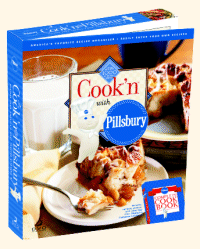
|
Never miss another recipe... Sign up for our free monthly newsletter today!
Subscribing will not result in more spam! I guarantee it! NEWSLETTER
• Current Issue• Newsletter Archive • Sign Up Now 
Cook'n with Betty Crocker 
Cook'n with Pillsbury 
Cook'n with a Taste of Home 
Cook'n in Italy 
Cook'n in Mexico |
 |
Fat Facts |
|
Print this Recipe The story on fat is not all bad. Fat is a nutrient, just like protein, carbohydrate, vitamins and minerals. Fat helps keep us healthy because it: * Provides linoeic acid, a fatty acid essential to proper growth, healthy skin and the metabolism or construction of cholesterol in the liver. * Helps transport, absorb and store the fat-soluble vitamins A, D, E and K. * Insulates and cushions body organs. * Supplies energy. It’s the most concentrated source of calories (9 calories per gram of fat versus 4 calories per gram for protein and carbohydrate). * Satisfies us. Because fat takes longer to digest, it helps control hunger. It is responsible for the creamy texture of ice cream, the crispness of chips and French fries and the flavorful tastes of many other foods. Sources of Fat You don’t have to search long or hard to find a few sources of fat in your food. Fat is found in meat, fish and poultry. It is also found in sauces, dressings, butter, margarine, oils, and even in plant sources like nuts and avocados. But don’t let fat fool you; hidden fat is abundant too. Fat is an integral part of baked foods and many snacks foods, and it can be found in all sorts of dairy foods. Over the past forty years, Americans have cut back on the amount of fat they eat, and manufacturers have responded by developing thousands of low-fat or fat-free products. While many of these products have helped us cut our fat intake, we still have a ways to go on the fat front. Health experts recommend no more than 30 percent of the calories you eat in a day come from fat. The greatest amount of fat in the American diet comes from fats and oils, salad dressings, gravies, sauces and candy. The next source of fat in the diet is meat, fish and poultry. Look at the pie chart above, and you can see how fat fits into the daily diet. 35% Meat, Fish and Poultry 14% Mixed Dishes 13% Fats and Oils 12% Desserts and Sweets 9% Milk Products 8% Grain Products 5% Fruits and Vegetables 5% Other Source: General Mills Dietary Intake Study, 1990-1992 The Many Faces of Fat All fats are made up of building blocks called fatty acids. Fatty acids are either saturated, monounsaturated or polyunsaturated. Though some fats, such as monounsaturated and polyunsaturated may be “better” than others for y9our health, the best advice for eating well is to eat a diet low in all types of fat. Saturated Versus Unsaturated Fats Saturated fats are solid at room temperature and are found primarily in foods from animal sources. Foods that contain higher amounts of saturated fats include meats, eggs and dairy products (whole milk, hard cheese, butter and cream). Tropical fats (coconut, palm and palm kernel oils) are considered saturated fatty acids, yet they are unique because they come from plants. Health experts recommend saturated fat is limited to 10 percent of calories or less each day. The downside of saturated fats. Research demonstrates a solid link between a diet high in saturated fats and the incidence of high blood cholesterol. Saturated fats raise low-density lipoprotein (LDL) cholesterol in the blood (the artery-clogging cholesterol). Eating saturated fats raises blood cholesterol more than eating any other type of fat, and more than the actual cholesterol found in food. Unsaturated fats come primarily from plant sources. They are usually liquid at room temperature. There are tow types of unsaturated fats, monounsaturated and polyunsaturated. Olive oil, canola oil and peanut oil are high in monounsaturated fats; corn, soybean, safflower and sunflower oils contain proportionately more polyunsaturated fats. All foods that contain fat are actually made up of mixtures of saturated and unsaturated (monounsaturated and/or polyunsaturated) fatty acids. In fact, even fats such as cooking oils and margarine contain a mixture of the three. The upside of unsaturated fats. When unsaturated fats replace saturated fats in the diet, blood cholesterol levels can go down. Polyunsaturated fats can also help lower blood cholesterol levels by lowering LDL cholesterol. Unfortunately, they also lower HDL cholesterol (the good cholesterol that can remove plaque from artery walls). Monounsaturated fats, on the other hand, help more. They lower LDL cholesterol and may actually increase HDL cholesterol. The key to success for either of these fats is a diet low in total fat, and particularly low in saturated fat. Wait, There’s More… Two other types of fat that affect your health are trans fatty acids and omega-3 fats. Trans fatty acids (TFA) are formed during hydrogenation—a process that changes liquid fats into a more solid and saturated form. Food manufacturers use hydrogenated fats because they improve the shelf life and stability of a product. Highly unsaturated vegetable oils, such as safflower or sunflower oil, are not stable enough to use in some food products because they develop off flavors within a short period of time. Check the labels of cookies, snack foods and bakery products. You’ll see that many list hydrogenated oil as one of the ingredients. The downside of trans fats. When it comes to blood cholesterol levels, trans fats act more like a saturated fat than the unsaturated fat they started out as. Trans fats are believed to raise blood cholesterol levels, including LDL cholesterol, and lower HDL cholesterol levels when they are substituted for polyunsaturated fats in the diet. But when trans fats are substituted for saturated fats, research has found that cholesterol levels can fall. Some research has also linked trans fats with an increased risk for certain cancers. Omega-3 fats, often referred to as fish oils, are unsaturated fats found primarily in certain kinds of fish, particularly salmon, mackerel, trout and albacore tuna. They are also found in high concentrations in flax seed, which is not especially common but is finding its way on to the shelves of many health food stores. The seeds have a high oil content and are sometimes ground into a flour, mixed with liquid and used to add body to baked goods. The upside of omega-3 fats. Studies show omega-3 fatty acids may reduce the risk for heart disease and stroke by lowering blood cholesterol levels and decreasing the likelihood of clots forming in the blood. How much of an impact do they have? One study found that middle-aged men who ate the equivalent of an ounce of fish a day were 44 percent less likely to have a heart attack than men who did not eat fish. The American Heart Association (AHA) recommends eating several servings of fish a week. If fish is not a favorite in your family, other good sources for omega-3 fats are soybean and canola oils. What’s The Bottom Line? Too much of any kind of fat, including the fats classified as good, such as olive oil and fish oils, can sabotage your efforts to eat well. If you reduce all fats in your diet and eat proportionately more unsaturated fat than saturated, you’ll be on the right track for good health. (See Fat Trimming Tips..). Reducing Fat In The Diet Currently, about 34 percent of the calories in the average American diet come from fat. This represents about 75 grams of total fat in a typical 2,000-calorie diet. That is the equivalent of 5 tablespoons (or more than 1/4 cup) of solid margarine per day. The AHA and many other health organizations recommend that healthy adults reduce their total fat intake to less than 30 percent of calories a day (about 65 grams in a 2,000-calorie diet). Keep in mind this guideline applies to an entire day’s worth of foods, not to a single food or recipe. For example, you might eat a low-fat breakfast and lunch and then splurge on a small piece of chocolate cake for dessert. Even though the cake may not be a low-fat food, that’s okay as long as it fits into your total fat or calorie budget for the day. You don’t have to go totally fat free, nor is it advised that you cut out all fats from your diet. To maintain a healthy diet, it is most important to look at what you eat over the long haul. From "Betty Crocker's Low-Fat, Low-Cholesterol Cooking Today." Text Copyright 2005 General Mills, Inc. Used with permission of the publisher, Wiley Publishing, Inc. All Rights Reserved. This recipe comes from the Cook'n collection. Try Cook'n for FREE! Here’s to your health Fat Facts Understanding Cholesterol Other Important Nutrients Putting It All Together Reading a Nutrition Label Go Slow For Success Test Your Health IQ The Skinny on Fat Cholesterol Trimming Tips Nutritional Comparison |
|
|
Affiliate Program | Privacy Policy | Other Resources | Contact Us
© 2008 DVO Enterprises, Inc. All rights reserved. Sales: 1-888-462-6656 |

